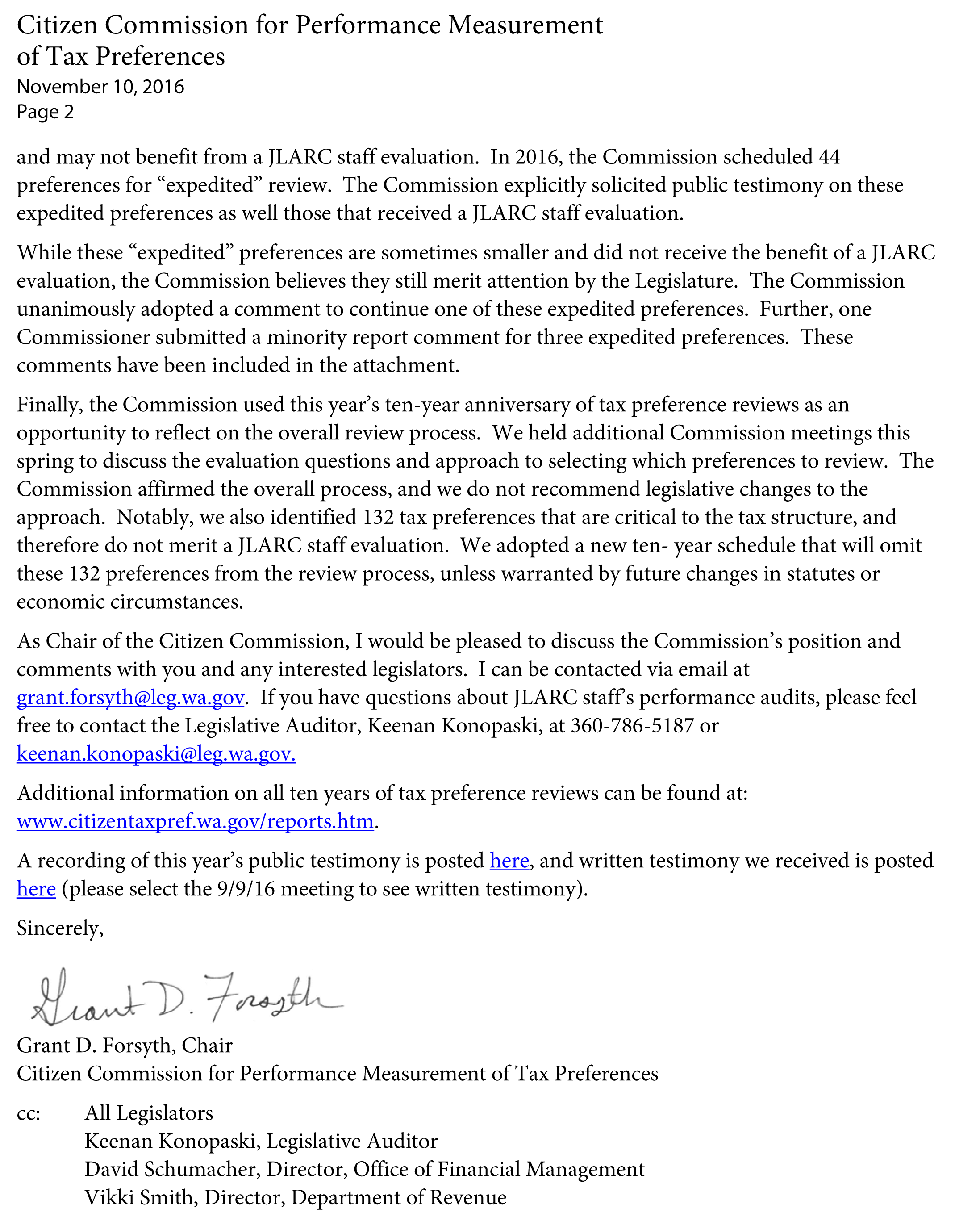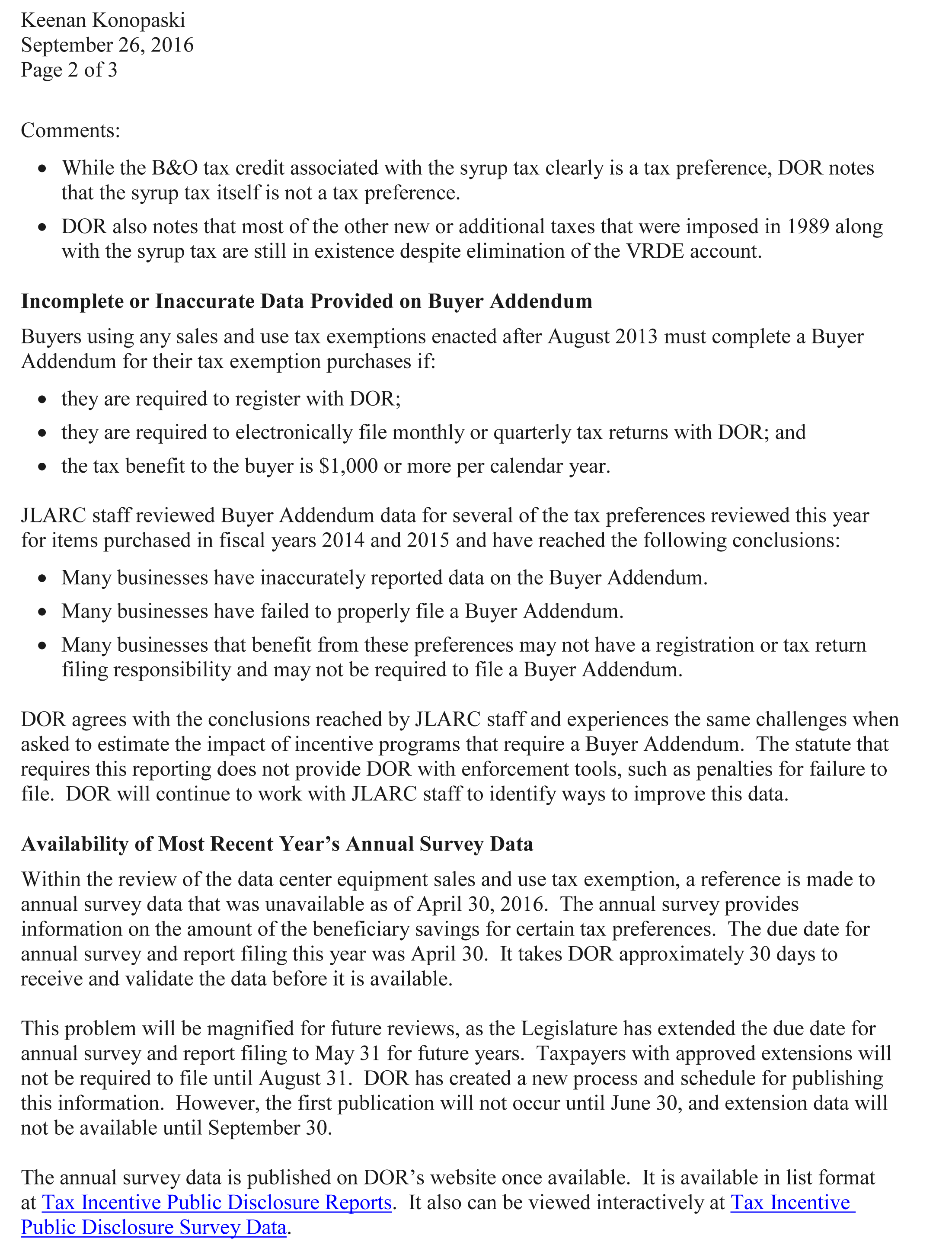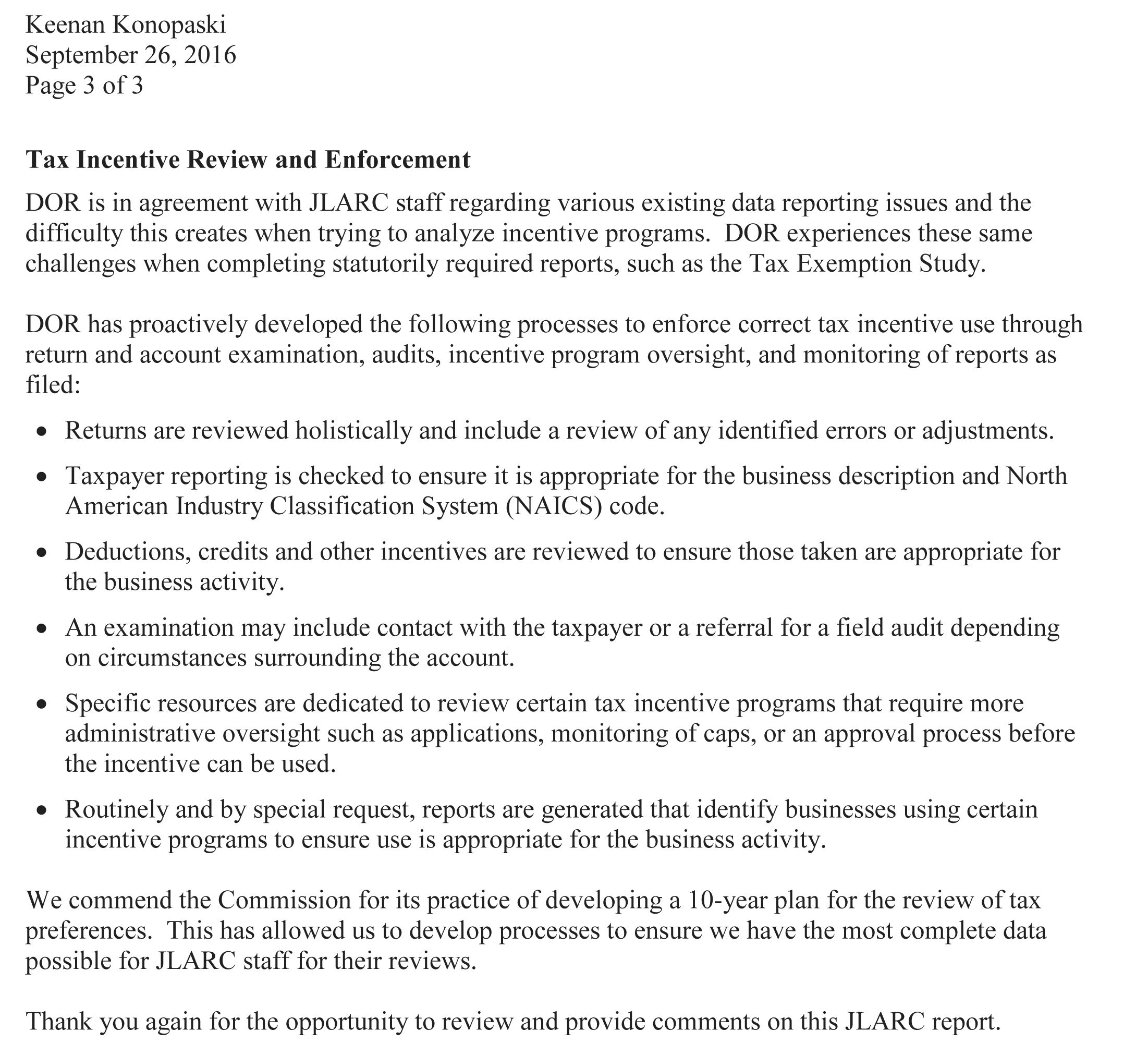JLARC Final Report: 2016 Tax Preference Performance Reviews
Report 17-02, January 2017
Flavor-Imparting Items | Sales & Use Tax
- Summary of this Review
- Details on this Preference
- Recommendations and Agency Response
- How We Do Reviews
- More about this Review
| The Preference Provides | Tax Type | Estimated Biennial Beneficiary Savings |
|---|---|---|
A sales and use tax exemption to restaurant owners on purchases of certain items that impart flavor during the cooking process. The preference only applies to items that are:
|
Sales & Use RCWs 82.08.210; 82.12.210 |
Unknown |
| Public Policy Objective |
|---|
| The Legislature stated the public policy objective for this preference was to provide tax relief to the restaurant industry for specific business inputs that cannot be reused and that are used in the cooking process to impart flavor to food. The Legislature also stated it intended:
|
| Recommendations |
|---|
|
Legislative Auditor’s Recommendation
Review and Clarify: While the preference is achieving the stated objective of providing tax relief to restaurant owners, it is unclear if the actual fiscal impact substantially conforms to the 2013 fiscal estimate. Commissioner Recommendation: The Commission endorses the Legislative Auditor’s recommendation. While the stated objective of this preference was to provide tax relief, it also avoided a tax dispute between the Washington Department of Revenue and taxpayers regarding the application of the ingredients exemption to the retail sales tax. As the Legislature reviews the actual fiscal impact of this preference, it should also consider continuing it as a clarification of longstanding sales tax principles. |
- What is the Preference?
- Legal History
- Other Relevant Background
- Public Policy Objectives
- Are Objectives Being Met?
- Beneficiaries
- Reporting Issues
- Revenue and Economic Impacts
- Other States with Similar Preference?
- Applicable Statutes
The Legislature established this preference with the stated intent to provide tax relief for the restaurant industry.
Because of the preference, restaurant owners do not pay sales or use tax on their purchase of certain items that impart flavor to food during the cooking process. The preference only applies to items that are:
- Completely or substantially consumed by combustion during the cooking process (e.g., wood chips, charcoal, charcoal briquettes, and grape vines); or
- Fully made from wood and provide support to the food during the cooking process (e.g., cedar grilling planks).
The preference does not apply to any type of gas fuel.
Restaurant owners must report the tax-exempt purchases to the Department of Revenue (DOR) using a "Buyer's Sales and Use Tax Preference" ("Buyer Addendum") when they file their tax returns unless the restaurant owners meet certain criteria that excuse them from completing an Addendum.
The preference took effect October 1, 2013, and is scheduled to expire July 1, 2017.
Pre-2012
In the past, the Department of Revenue’s (DOR) interpretation of statute was that restaurant owners were required to pay sales or use taxes on their purchases of fuel or heating sources used to cook food.
DOR considered restaurant owners’ purchases of ingredients used to flavor food as tax-exempt because these items become part of the final meal sold to the customer.
2012
Audits by DOR found that some restaurant owners had not paid sales or use tax on their purchases of charcoal briquettes used to cook customer meals. DOR’s interpretation of statute considered the briquettes a heating source, and the agency assessed tax on the owners.
The restaurant owners appealed the assessments, claiming that while the charcoal briquettes were a heating source, they also imparted a specific flavor to the grilled food. By imparting this flavor, the owners asserted that the briquettes became an ingredient or component of the final meal sold to the customer. Ingredients and components that are added to the final product sold to a customer are exempt from sales and use tax.
In a published determination, DOR rejected the restaurant owners’ appeal. DOR noted that the sales tax exemption for ingredients and components was meant to apply only to manufacturing activities and not to food preparation activities by restaurants.
2013
The Legislature enacted this tax preference. The Legislature stated its intent was to provide tax relief for the restaurant industry for specific items used in the cooking process that impart flavor to food. The preference was made temporary to allow the Legislature to assess the fiscal impact and use of the preference.
What is a Restaurant?
Statute defines a “restaurant” as any establishment with special space and accommodation where food and beverages are regularly sold to the public for immediate, but not necessarily on-site, consumption. This does not include grocery stores, mini-markets, and convenience stores. Examples of restaurants include:
- Independent establishments, such as lunch counters, diners, bars, and coffee shops.
- Places within a larger facility where food and drinks are sold for immediate consumption, and for a separate fee, such as hotels.
- Mobile sales units that sell food or drinks for immediate consumption within a place charging an admission fee.
- Public and private carriers, such as trains and vessels, that sell food or drinks for immediate consumption for a separate fee.
Restaurants’ Tax Responsibilities
Restaurant owners are generally required to collect sales tax from customers on all of their sales of meals, food to go, and catering activities.
The tables below provide examples of items restaurant owners must pay sales or use taxes on, and items that are tax-exempt. Additional taxes not listed in these tables may also apply to restaurants, such as liquor or syrup taxes.
| Restaurant Owners are the Consumers and Pay Sales or Use Tax on... |
|---|
| Chairs, table, and furnishings |
| Dishes, silverware, and plastic trays |
| Janitorial supplies, pest control services, vending machine purchases and rentals |
| Equipment (ovens, grills, pots, pans, baking sheets, etc.) |
| Repair parts and labor |
| Restaurant Owners Resell and Don’t Pay Sales or Use Tax on... |
|---|
| Food inventory and meal ingredients |
| Liquor, beer, and wine |
| Soft drinks |
| Paper or plastic plates, cups, lids, utensils; paper napkins, toothpicks, and straws; “to-go” containers |
Additional Tax Preferences Directed to Restaurant Owners and Other Food Service Businesses
Several other tax preferences are directed to restaurant owners and other food service businesses. These businesses may also qualify for other, broader tax preferences.
| Preference | Tax Type | Enacted | JLARC Staff Review? |
|---|---|---|---|
| Purchases of food or food
ingredients that become part of a meal sold by a restaurant |
Sales and use tax exemption | 1977 | Exempted from review |
| Free meals provided by restaurant owners to their employees | B&O tax exemption Sales and use tax exemption |
2011, clarified in 2015 | Not yet reviewed |
| Returnable containers for beverages and food | Sales and use tax exemption | 1974 | Expedited review in 2010 |
| Credit for the amount of syrup tax paid | B&O tax credit | 2006 | Full review in 2016 |
What are the public policy objectives that provide a justification for the tax preference? Is there any documentation on the purpose or intent of the tax preference?
Provide Tax Relief
The Legislature stated the public policy objective for this preference was to provide tax relief to the restaurant industry for specific business inputs that cannot be reused and that are used in the cooking process to impart flavor to food.
Substantially Conform to 2013 Fiscal Estimate
The Legislature also stated its intent to provide the preference “in a fiscally responsible manner” where the actual revenue impact “substantially conforms” to the 2013 fiscal estimate. The Legislature stated it intended the preference to be temporary so it could:
- Assess the actual fiscal impact of the preference; and
- Assess whether the items exempted by the preference were being used in a manner consistent with an ingredient or component that becomes part of the end product sold to the consumer.
The Legislature identified its objectives for this tax preference in an intent section rather than in a tax preference performance statement.
What evidence exists to show that the tax preference has contributed to the achievement of any of these public policy objectives?
The preference is meeting the public policy objective of providing tax relief to the restaurant owners who claim the exemption when they purchase flavor-imparting items.
It is not clear how many restaurants are doing so because few are reporting these purchases on a Buyer Addendum.
It is also not clear whether the actual use of the preference substantially conforms to the fiscal estimate, or whether restaurants are using flavor-imparting items in a manner consistent with an ingredient or component that becomes part of the end product.
Provide Tax Relief
The preference is providing tax relief to restaurant owners who claim the exemption. Of the estimated 14,000 or more restaurants in Washington, 25 restaurant owners in Fiscal Year 2014 and 33 restaurant owners in Fiscal Year 2015 reported purchasing flavor-imparting items on a Buyer Addendum. Vendors selling these items to restaurant owners reported four times as many sales as restaurants reported on Buyer Addenda. Therefore, it is possible that many more restaurants are using the preference but not filing Buyer Addenda.
Substantially Conform to 2013 Fiscal Estimate
It is not clear whether the actual fiscal impact of this tax preference substantially conforms to the Department of Revenue’s (DOR) 2013 fiscal estimate. For the nine months of Fiscal Year 2014 that are disclosable, actual taxpayer savings reported were 90 percent higher than the DOR estimate.
Ideally, two sources of information would be available to compare actual impacts to the 2013 estimate:
- Vendors selling flavor-imparting items to restaurants would report these tax-exempt sales on their tax returns; and
- Restaurant owners buying flavor-imparting items would file a Buyer Addendum detailing their tax-exempt purchases.
In this case, information on vendor sales is available for part of Fiscal Year 2014 after the preference became effective, but the number of businesses reporting for Fiscal Year 2015 is too small to allow disclosure. Additionally, Buyer Addendum information from restaurant owners appears to be under-reported (see the tab on Reporting Issues for more detail). The Legislature has also not expressly defined what it means by “substantially conforms.”
The exhibit below compares nine months of actual Fiscal Year 2014 taxpayer savings as reported by vendors with the 2013 fiscal estimate from DOR for this same time period. These nine months followed the effective date of the preference. Reported taxpayer savings were 90 percent higher than DOR’s 2013 fiscal estimate.
| Fiscal Year | DOR Estimate of Taxpayer Savings | Taxpayer Savings Reported by Vendors | Percent Reported Taxpayer Savings Differs from |
|---|---|---|---|
2014 (10/01/13 – 6/30/14)
|
$41,000
|
$78,000
|
90% higher
|
There is no documentation or data available to help inform whether restaurant owners use tax-exempt flavor-imparting items in a manner consistent with an ingredient or component that becomes part of the end product. DOR audit staff report the exemption is still relatively new and this issue has not been the subject of any of their audits.
To what extent will continuation of the tax preference contribute to these public policy objectives?
Continuing the tax preference beyond the current July 1, 2017, expiration date would continue to provide tax relief to the restaurant owners who purchase tax-exempt flavor-imparting items.
It is not clear how continuing the preference would contribute to the Legislature’s stated intent for impacts to substantially conform to the fiscal estimate, since the actual taxpayer savings is unknown.
Who are the entities whose state tax liabilities are directly affected by the tax preference?
Direct Beneficiaries
Direct beneficiaries of this tax preference are restaurant owners who purchase charcoal, wood chips, grape vines, or other qualifying items to infuse flavor into food during the cooking process, or use cedar planks to cook food.
The total number of direct beneficiaries is unknown. Of the estimated 14,000 or more restaurants in Washington, 25 restaurant owners in Fiscal Year 2014 and 33 restaurant owners in Fiscal Year 2015 reported purchasing flavor-imparting items on the Buyer Addendum. Vendors selling these items to restaurant owners reported four times as many sales as restaurants reported on Buyer Addenda. Therefore, it is possible that many more restaurants are using the preference but not filing Buyer Addenda.
Indirect Beneficiaries
To the extent that restaurant owners using this preference pass along their tax savings to customers, the indirect beneficiaries of this preference may be customers of these restaurants.
Three Reporting Issues
Three reporting issues complicate publishing an estimate of beneficiary savings for this preference:
- Sales and related tax information from vendors selling flavor-imparting items to restaurants are not disclosable for Fiscal Year 2015;
- Information provided by restaurant owners using a Buyer Addendum appear to be under-reported; and
- Some Buyer Addendum data appears to be inaccurate.
Fiscal Year 2015 Sales from Vendors to Restaurants Not Disclosable
Fewer than three vendors reported sales of flavor-imparting items in Fiscal Year 2015. The Department of Revenue’s (DOR) taxpayer confidentiality policy prohibits disclosure of tax return data if it is comprised of fewer than three taxpayers. JLARC staff contacted the businesses to request specific authorization to disclose the tax return data, but all of the businesses did not respond. The estimated beneficiary savings are based on the only disclosable tax data, which is from the nine months of Fiscal Year 2014 that followed the effective date of this preference.
Use of Preference is Likely Under-reported by Restaurants
Buyers using any sales and use tax exemptions enacted after August 2013, including this one, must complete a Buyer Addendum for their tax exemption purchases if:
- They are required to register with DOR;
- They are required to file monthly or quarterly tax returns with DOR; and
- The tax benefit to the buyer is $1,000 or more per calendar year.
Of the estimated 14,000 or more restaurants in Washington, only 25 restaurant owners in Fiscal Year 2014 and 33 restaurant owners in Fiscal Year 2015 reported purchasing flavor-imparting items on a Buyer Addendum. However, vendors selling these items to restaurants owners reported four times as many sales. For example, vendors of flavor-imparting items reported sales of $868,000 for nine months in Fiscal Year 2014. During that same time period, restaurant owners only reported $208,000 in purchases of flavor-imparting items. The discrepancy between vendor-reported and restaurant-reported data suggests that many tax-exempt flavor-imparting item purchases are not reported by restaurant owners on a Buyer Addendum.
Buyer Addendum Reporting by Restaurants Appears to be Inaccurate
JLARC and DOR staff reviewed Buyer Addendum data from restaurant owners who reported using the tax preference to purchase items in Fiscal Years 2014 and 2015. Many businesses have inaccurately reported data. This means that not only is there likely under-reporting, but for those that do report, they may be inaccurately reporting exemptions for items that do not qualify for this preference.
DOR states that taxpayers seem to have misunderstood what items qualified for the flavor-imparting preference. A common mistake was that restaurant owners thought purchases of syrup used to make carbonated beverages should be reported on the Addendum.
What are the past and future tax revenue and economic impacts of the tax preference to the taxpayer and to the government if it is continued?
JLARC staff estimate that the direct beneficiaries of the preference saved $78,000 in Fiscal Year 2014. The direct beneficiary savings for the 2015-17 Biennium is unknown. This estimate is based on Department of Revenue tax return data from vendors who sell to restaurant owners. Estimated savings for Fiscal Year 2015 are not disclosable due to fewer than three businesses reporting information. As a result, estimated beneficiary savings for the 2015-17 Biennium are unknown because the base period used to estimate the savings is not disclosable.
See the tab on Reporting Issues for more information on the challenges associated with this estimate.
| Fiscal Year | Total Deductions | State Sales Tax | Local Sales Tax | Total Beneficiary Savings |
|---|---|---|---|---|
2014
|
$868,000
|
$57,000
|
$21,000
|
$78,000
|
2015
|
Not Disclosable
|
Not Disclosable
|
||
2016
|
Unknown
|
Unknown
|
||
|
2017 |
Unknown
|
Unknown
|
||
| Preference scheduled to expire effective July 1, 2017 | ||||
2015-17 Biennium
|
Unknown
|
Unknown
|
||
If the tax preference were to be terminated, what would be the negative effects on the taxpayers who currently benefit from the tax preference and the extent to which the resulting higher taxes would have an effect on employment and the economy?
If the tax preference is terminated or allowed to expire as scheduled, restaurant owners who use certain flavor-imparting items for cooking would pay sales or use tax on their purchases as they did prior to October 1, 2013. The effect of termination or expiration on employment and the economy would depend on the extent to which restaurant owners could absorb the increased costs or pass them along to customers.
Do other states have a similar tax preference and what potential public policy benefits might be gained by incorporating a corresponding provision in Washington?
Of the 45 states and the District of Columbia with a sales and use tax, there are three states where flavor-imparting items are not subject to sales tax: California, Florida, and Missouri.
The exemptions in these states are defined more broadly as sales for resale. These states have determined that a portion of the flavor-imparting item is incorporated in the final product that is resold to the restaurant customer.
Intent Statement
Intent—2013 2nd sp.s. c 13: "The intent of part V of this act is to provide tax relief to restaurants for business inputs that cannot be reused and are consumed for a specific purpose during the cooking process. More specifically, it is the intent of part V of this act to provide a sales and use tax exemption for specific items used in the cooking process that impart flavor and therefore are similar to an ingredient added to a final product that is sold to the consumer. It is also the intent of the legislature to provide this tax preference in a fiscally responsible manner where the actual revenue impact of the legislation substantially conforms with the fiscal estimate provided in the legislation's fiscal note. Therefore, the legislature intends for this tax preference to be temporary so the legislature can assess the actual fiscal impact of the tax preference and whether the tangible personal property subject to the exemption is being used in a manner consistent with an ingredient or component that becomes part of a product sold to a final consumer." [2013 2nd sp.s. c 13 § 501.]
RCW 82.08.210
Exemptions—Flavor imparters—Restaurants. (Expires July 1, 2017.)
(1) Except as provided in subsection (2) of this section, the tax levied by RCW 82.08.020 does not apply to sales to restaurants of products that impart flavor to food during the cooking process and that:
(a) Are completely or substantially consumed by combustion during the cooking process, such as wood chips, charcoal, charcoal briquettes, and grape vines; or
(b) Support the food during the cooking process and are comprised entirely of wood, such as cedar grilling planks.
(2) The exemption provided by this section does not apply to any type of gas fuel.
(3) Sellers making tax-exempt sales under this section must obtain an exemption certificate from the buyer in a form and manner prescribed by the department. The seller must retain a copy of the exemption certificate for the seller's files. In lieu of an exemption certificate, a seller may capture the relevant data elements as allowed under the streamlined sales and use tax agreement. For sellers who electronically file their taxes, the department must provide a separate tax reporting line for exemption amounts claimed under this section.
(4) For purposes of this subsection, "restaurant" has the same meaning as provided in RCW 82.08.9995.
(5) This section expires July 1, 2017.
[2013 2nd sp.s. c 13 § 502.]
RCW 82.12.210
Flavor imparters—Restaurants. (Expires July 1, 2017.)
(1) Except as provided in subsection (2) of this section, the provisions of this chapter do not apply to restaurants with respect to the use of products that impart flavor to food during the cooking process and that:
(a) Are completely or substantially consumed by combustion during the cooking process, such as wood chips, charcoal, charcoal briquettes, and grape vines; or
(b) Support the food during the cooking process and are comprised entirely of wood, such as cedar grilling planks.
(2) The exemption provided by this section does not apply to any type of gas fuel.
(3) For purposes of this subsection, "restaurant" has the same meaning as provided in RCW 82.08.9995.
(4) This section expires July 1, 2017.
[2013 2nd sp.s. c 13 § 503.]
- Legislative Auditor Recommendation
- Letter from Commission Chair
- Commissioners’ Recommendation
- Agency Response
Legislative Auditor Recommendation
The Legislature should review and clarify the sales and use tax exemption for flavor-imparting items because while the preference is achieving the stated public policy objective of providing tax relief to restaurant owners, it is unclear if the actual fiscal impact substantially conforms with the 2013 fiscal estimate.
The preference is scheduled to expire on July 1, 2017.
Legislation Required: Yes.
Fiscal Impact: Depends on legislative action.


The Commission endorses the Legislative Auditor’s recommendation.
While the stated objective of this preference was to provide tax relief, it also avoided a tax dispute between the Washington Department of Revenue and taxpayers regarding the application of the ingredients exemption to the retail sales tax. As the Legislature reviews the actual fiscal impact of this preference, it should also consider continuing it as a clarification of longstanding sales tax principles.
Joint Department of Revenue and Office of Financial Management Response


